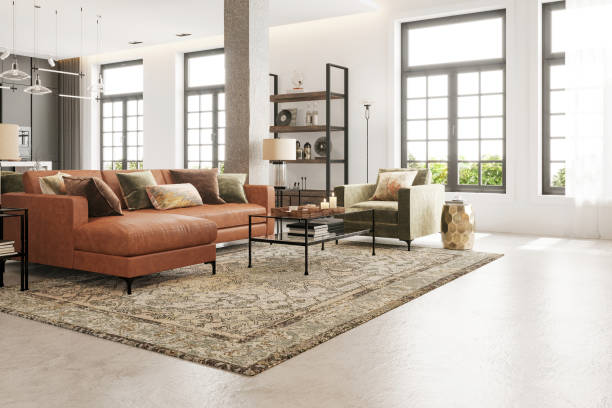Creating the perfect living space can be challenging, especially when dealing with uniquely shaped rooms. Traditional rugs only sometimes fit these spaces properly, leaving areas unbalanced or awkward. Custom area rugs can be the perfect solution to design challenges in oddly shaped rooms. By tailoring rugs to specific dimensions and layouts, homeowners can ensure that every corner and curve is addressed, leading to a harmonious and aesthetically pleasing environment.
Custom rugs offer flexibility in design and materials, allowing for a seamless blend with the room’s existing decor. For example, a modular sofa in an irregularly shaped room can be complemented with a rug designed to fit perfectly beneath it. For those looking to design your custom rugs, choosing the right fibers and patterns can make a significant difference in achieving the perfect look.
With the ability to match colors, textures, and patterns, custom rugs provide a unique opportunity to improve a room’s style. They can help define areas within larger spaces or create cozy corners in L-shaped or other unusual layouts. This adaptability makes them a valuable addition to any home decor strategy.
Maximizing Aesthetics with Custom Rug Solutions
Creating an aesthetically pleasing space in uniquely shaped rooms can be challenging. Custom area rugs can help accentuate unique room shapes, support the choice of materials, and coordinate colors and patterns.
Accentuating Unique Room Shapes
A custom rug can make a significant difference in oddly shaped rooms. Unlike standard rugs, a custom rug can be tailored to fit narrow hallways or irregular spaces, ensuring there are no awkward gaps. This precision improves the room’s flow and harmony.
For instance, custom-sized rugs can follow the room’s lines, adding balance. Whether you have a circular or L-shaped room, a custom rug can cover the space perfectly. This helps to emphasize the room’s curvature or angles, making the design more cohesive.
Choosing the Right Materials
Material choice is important in both aesthetics and functionality. Wool and jute are popular for their durability and texture. Wool, in particular, brings warmth and softness, ideal for living rooms or bedrooms. Jute rugs offer a natural, earthy feel, which works well in spaces aiming for an organic or rustic look.
Custom rugs allow you to choose materials that match your lifestyle and interior design preferences. Selecting the right fabric means your rug not only fits perfectly but also improves the room’s overall feel.
Color and Pattern Coordination
Colors and patterns play a key role in maximizing a room’s aesthetics. When it comes to custom rugs, you have the flexibility to choose from vibrant colors, neutral tones, and versatile patterns. This can help tie together different elements of the room.
A custom area rug with bold patterns can make a statement in a minimalist space, while tone-on-tone patterns like ivory or earth tones blend seamlessly with existing décor. Coordinating the rug’s color with the room’s color schemes ensures a harmonious look. The ability to select specific colors and patterns makes custom rugs an excellent solution for unique design dilemmas.
Functional Considerations for Rug Placement
Custom area rugs can solve many design challenges in uniquely shaped rooms. Key considerations include how furniture arrangement impacts rug sizing, how rugs define spaces in open floor plans, and how to maintain custom rugs.
Furniture Arrangement and Rug Sizing
Choosing the right rug size is important when arranging furniture. In a living room, placing a large rug under the sofa can unify the space. Make sure the front legs of the sofa and chairs rest on the rug for a balanced look. Smaller rugs can be useful under side tables or in reading nooks to add texture and warmth.
In bedrooms, a custom rug placed under the bed but extending beyond the bedside creates symmetry. For odd-shaped rooms, custom rugs can be tailored to fit the unique layout, ensuring no awkward gaps. This helps in tying together all furniture pieces for a cohesive look.
Defining Spaces in Open Floor Plans
Open floor plans benefit greatly from custom area rugs. These rugs can help in defining separate zones such as living, dining, and kitchen areas. For instance, placing a large rug under the dining table distinguishes this area from the living space.
Runners are ideal for connecting adjoining rooms or hallways. They guide traffic flow while adding a stylistic touch. Custom rugs can be used to emphasize symmetry and organization in spaces that might otherwise feel chaotic.
Another effective strategy is to coordinate colors and rug styles across different rugs in the open floor plan. This creates a unified look even though the space serves multiple functions.
Maintaining and Upkeeping Custom Rugs
Maintaining custom rugs is essential for longevity and appearance. Regular vacuuming helps in removing dust and debris. Rotating rugs every few months prevents uneven wear, especially in high-traffic areas. Spot cleaning is important for immediate stains, and professional cleaning should be considered annually.
For different textures and materials, follow specific care instructions. Wool rugs, for example, require gentler cleaning techniques compared to synthetic rugs. Proper maintenance ensures that custom rugs remain a focal point in your unique room layout, improving both aesthetics and functionality.
Custom rugs are an investment, and taking the time to maintain them will keep your spaces looking stylish and well-defined.
Conclusion
Custom area rugs are a versatile solution for uniquely shaped rooms. They can adapt to any space, adding comfort and style while defining the room’s layout. Whether it’s a small nook or a large, open area, a custom rug can bring harmony and a cohesive look. With options like geometric patterns or unique shapes, custom rugs meet both aesthetic and functional needs.
Published by HOLR Magazine.


